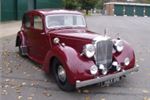Alvis TA14 (1946 – 1950) Review
Alvis TA14 (1946 – 1950) At A Glance
The Alvis TA14 was one of the first British cars to go into production after WW2, although in reality it was a mildly modified version of the pre-war 1938 12/70 and not a new car at all. Despite this, it was Alvis’s post-war best-seller – a fact more relevant when one considers how much Alvis moved upmarket after the TA14.
The pre-war specification means cart springs and mechanically operated brakes, although the track was slightly wider and the wheelbase was lengthened. The engine was bored out by an extra 50cc to 2.0-litres, but extra weight over the 12/70 means the TA was not really any quicker, topping out at 75mph.
The TA14 was also available as a convertible. The Cabriolet version was introduced alongside the saloon, and two drophead bodies were offered from the start – one by Tickford and the other by Carbodies. All versions featured the same front-end treatment, and the interior had high-quality leather seats.

.jpg?width=640&height=426&rmode=crop)
.jpg?width=640&height=426&rmode=crop)


 Pre-war roots mean rod-operated brakes and cart springs
Pre-war roots mean rod-operated brakes and cart springs
 High quality construction, a choice of coachbuilt dropheads
High quality construction, a choice of coachbuilt dropheads
